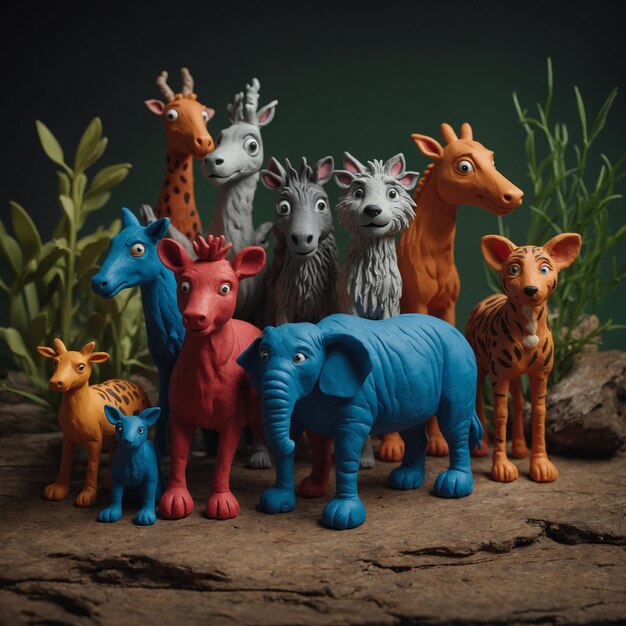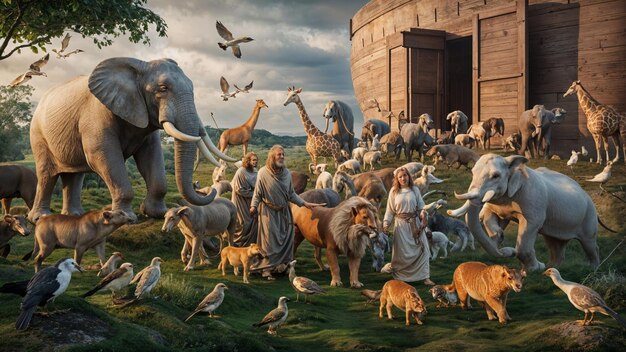The Challenges of Domestication: Why Some Animals Refuse to Be Tamed
Domestication, the process of taming wild animals for human use, has been a significant milestone in human history. It started around 10,000 BC with the taming of horses, goats, pigs, and sheep (
Mellars, 2006
). However, not all animals have responded equally to domestication efforts. Some species, despite numerous attempts, remain wild and refuse to be tamed. This phenomenon raises several intriguing questions about the reasons behind these animals’ resistance to domestication.
Biological Challenges:
One of the most apparent reasons is biological
genetic predisposition
. Certain species may have a lower tolerance for living in human-dominated environments. For example, elephants
(Loxodonta africana)
are highly intelligent, social, and have complex behaviors that are hard to replicate in captivity (
Plotnik et al., 2013
). Similarly, large carnivores
(e.g., lions, tigers, and bears)
present significant challenges due to their size, strength, and aggressive nature (
Packer et al., 2018
).
Behavioral Challenges:
Another challenge lies in behavioral traits
that make animals resistant to domestication.
For instance, porcupines
(Erethizon dorsatum)
are known for their quills, which act as a deterrent to predators and humans alike (
Moehlman et al., 2017
). The skunk’s ability to spray a foul-smelling fluid
is another example of a behavioral trait that has made domestication difficult (Lee et al., 2019
).
Social and Ecological Challenges:
Moreover, some animals face social and ecological challenges
in their habitats that make domestication an unlikely prospect.
For example, polar bears
(Ursus maritimus)
live in harsh environments, with limited resources and extreme temperatures (
Cherry, 2018
). Similarly, rhinoceroses
(Rhinocerotidae)
are large, solitary animals with complex social structures and a strong need for vast territories (
Darst, 2013
).

Introduction
Domestication, a vital aspect of human history, refers to the process of taming wild animals and turning them into pets or farm animals. This transformation has profoundly impacted the way humans live, providing us with companionship, food, and labor (Bradshaw, J. et al., 2015). Understanding the challenges of domestication is essential for several reasons: ethical considerations and practical implications.
Ethical Considerations
Respecting animal autonomy and welfare is a fundamental ethical consideration in the process of domestication. Domesticated animals are no longer wild; they live under human care, and it is our responsibility to ensure their well-being. The question of animal autonomy – whether animals possess the capacity for conscious choices that should be respected – remains an ongoing debate (Regan, T., 2001). Regardless of one’s stance on this issue, it is clear that animals deserve humane treatment.
Practical Implications
On a practical level, successful human-animal relationships rely on the understanding of the challenges of domestication. Ensuring animals are well-adapted to their new environment and able to meet their needs is crucial for the health and happiness of both the animal and the human companion (Manning, A., 2015).
Why Some Animals are More Resistant to Domestication Than Others
Certain animals have proven more resilient to domestication than others due to various genetic, behavioral, and ecological factors. Some species possess inherent traits that make them less suitable for domestication, such as a strong wild instinct or an inability to thrive in human-controlled environments. Understanding why this is the case can provide valuable insights into the process of domestication and inform animal conservation efforts (Bradshaw, J. et al., 2015).
Genetic Factors
One explanation for why some animals resist domestication is their genetic makeup. For instance, certain breeds of dogs have been selectively bred for specific traits for thousands of years. In contrast, many wild animals have not undergone such intense genetic modification and may lack the necessary adaptations to thrive in captivity (Bradshaw, J. et al., 2015).
Behavioral Factors
Behavioral differences also play a role in an animal’s ability to be domesticated. Animals with strong social structures, such as elephants or primates, may find it challenging to adapt to life without their wild groups (Bradshaw, J. et al., 2015). Conversely, animals like cats and dogs have been domesticated due to their natural inclination towards forming close bonds with humans.
Ecological Factors
Ecological factors can also influence an animal’s ability to be domesticated. Animals that live in extreme environments, such as polar regions or deserts, may not thrive in more temperate conditions (Bradshaw, J. et al., 2015). Additionally, animals with specialized diets may not be able to adapt to the variety of food sources available in human-controlled environments.

The Biological Basis of Animal Behavior: Understanding Why Some Animals are More Suited to Domestication Than Others
Animal behavior is shaped by their biological makeup, including their genetics, physiology, and evolutionary history. Some animals are more amenable to domestication than others due to specific behavioral traits. Let’s explore these traits and the examples of animals that have been successfully or unsuccessfully domesticated.
Behavioral Traits That Make Animals More Amenable to Domestication
- Social structure: Living in groups and hierarchies allows animals to develop social skills, respond to human cues, and learn from each other. Domesticated animals like dogs and pigs exhibit strong social structures.
- Learning abilities: Capacity for conditioning and imprinting makes animals more adaptable to human care. Dogs, for instance, can be trained to perform various tasks, while cats are easily conditioned to use litter boxes.
- Temperament: Docility, curiosity, and playfulness make animals more suited for companionship with humans. Animals like dogs and cats display these traits.
Examples of Successfully Domesticated Animals Based on These Traits
- Dogs: Canines are pack animals with strong social structures. They have an excellent capacity for learning and bonding with humans.
- Cats: Felines exhibit curiosity, playfulness, and have a strong capacity for learning. They adapt well to human companionship.
- Pigs: Pigs live in social groups and have a strong capacity for learning. They are easily conditioned and make good companions.
Behavioral Traits of Animals That Are Less Suited to Domestication
- Solitary species: Animals that live alone or in small family groups, such as bears, are less likely to form bonds with humans.
- Fearful or aggressive animals: Lack of trust towards humans can make domestication difficult. Animals like big cats and elephants often display fearful or aggressive behaviors.
- Territorial animals: Strong attachment to their territory and unwillingness to share it can make domestication challenging for animals like bears.
Examples of Animals That Have Proven Difficult to Domesticate Based on These Traits
- Big cats (lions, tigers, leopards): Their fearsome nature and territorial behavior make domestication difficult.
- Elephants: These large, intelligent animals are highly social and territorial. Their size and intelligence make domestication an immense challenge.
- Bears: Bears are powerful, territorial animals that can be dangerous. While they have been domesticated in some cultures (e.g., polar bears), it remains a significant challenge.

I The Psychological Factors of Animal Behavior: Understanding the Emotional Challenges of Domestication
The importance of emotional bonding in successful domestication
Emotional bonding plays a crucial role in the successful domestication of animals. Bonding between mother and offspring is essential for forming a strong attachment that sets the foundation for tame behavior. This bond helps in developing trust, reducing fear, and fostering a sense of security. In the context of human-animal interaction, human-animal bonding is equally vital in building trust and understanding. This emotional connection enables animals to respond positively to their human caretakers, leading to a more manageable and cooperative animal.
Challenges in domestication due to fear, aggression or lack of emotional connection
Domestication poses challenges when animals exhibit fear, aggression, or a lack of emotional connection with humans. Fearful animals are often difficult to approach and handle due to their heightened anxiety response. Their fear can result from past traumas, lack of socialization, or unfamiliarity with humans. Aggressive animals, on the other hand, pose a threat to human safety and can hinder successful domestication. Their aggression can stem from various reasons, including fear, frustration, or a lack of socialization.
Strategies for fostering emotional bonding and overcoming fear or aggression in animals
To foster emotional bonding and overcome fear or aggression in animals, several strategies can be employed: Positive reinforcement: This technique involves rewarding desired behaviors to encourage the animal to repeat those actions. Rewards can be in the form of food, praise, or toys.
Consistent handling:
Providing predictability and routine in handling animals helps reduce their anxiety and fosters trust. Consistent handling also makes it easier for the animal to recognize and respond positively to human presence.
Patience and understanding:
Allowing animals to adjust to new environments at their own pace is essential in fostering emotional bonding. Patience and understanding enable caretakers to recognize the unique needs of each animal and respond accordingly, helping build a strong human-animal relationship.

The Social Context of Domestication:
Understanding the Role of Human Culture and Society in Shaping Animal Behavior
The impact of human culture on animal domestication:
- Differences in expectations and practices between different societies and regions have led to varying degrees of animal domestication. For instance, some cultures may prioritize working animals over companion animals, while others may focus on animals used for food production.
- Ethical considerations
are essential in balancing human needs with animal welfare. As we continue to domesticate animals, it is crucial to consider their wellbeing and minimize stressors and suffering.
The role of socialization in shaping animal behavior:
Socialization
- Early experiences greatly impact an animal’s future behavior and temperament. Proper socialization from birth to adulthood can lead to well-adjusted animals with positive attitudes towards their handlers and other animals.
- Social norms and values
influencing human attitudes towards animals
can shape the way we treat them, leading to improved welfare and relationships. For instance, cultures that view animals as companions rather than commodities often promote positive interactions between humans and animals.
The importance of education, training, and communication in successful domestication:
Education, training, and communication
are crucial in creating successful relationships between humans and animals. Proper training techniques, such as positive reinforcement, can encourage desired behaviors and strengthen the bond between humans and their domesticates.
- Techniques for positive reinforcement: rewarding desired behaviors, can be as simple as offering treats or praise, making animals more willing to learn and comply with requests.
- Strategies for managing undesirable behaviors:
consistency, patience, and understanding
are essential when dealing with challenging behaviors. By remaining calm and persistent, humans can help animals learn appropriate behavior and ultimately improve their overall welfare.

Conclusion
As we have explored throughout this discourse, the process of domestication has been a crucial chapter in human history. The domestication of animals not only shaped our agricultural and societal development but also raised significant ethical and practical considerations.
Recap of the Importance of Understanding the Challenges of Domestication
Firstly,, it is essential to emphasize the ethical implications of understanding the challenges of animal domestication. As we deepen our comprehension of animal behavior and needs, we can better respect their autonomy and promote their welfare. This includes acknowledging the emotional and psychological aspects of animal sentience and developing practices that minimize stress and improve overall well-being.
Ethical considerations: respecting animal autonomy and welfare
Secondly,, the practical implications of understanding the challenges of domestication cannot be overlooked. Successful human-animal relationships depend on a profound understanding of animal behavior and needs, enabling us to create harmonious environments that foster positive interactions between humans and animals.
Emphasis on the Need for Continued Research and Dialogue in this Area
Despite our progress, there is still much to be learned about the complexities of animal behavior and domestication. Continued research in this field is essential to further improve animal welfare, ensuring they lead fulfilling lives both in agricultural settings and as companions.
Exploring new methods and technologies to improve animal welfare
Firstly,, we must continue investigating novel techniques and technologies that can enhance animal well-being. These may include the use of virtual fencing to provide larger living spaces, improving feeding systems and housing designs, or incorporating enriching activities for animals.
a. Virtual Fencing
Virtual fencing, for example, uses a combination of sensors and GPS technology to create invisible barriers for animals. This can provide them with larger living areas while still maintaining human safety and property boundaries.
Encouraging public awareness and understanding of the complexities of animal behavior and domestication
Secondly,, it is essential to raise public awareness and understanding about the complexities of animal behavior and domestication. By fostering a more compassionate and informed society, we can create a strong foundation for ethical and effective practices that benefit both humans and animals.




